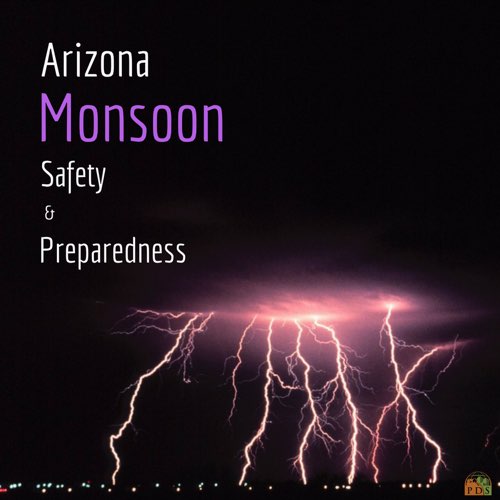
Arizona’s Monsoon Season: Preparing and Staying Safe
Arizona monsoons, part of a larger North American monsoon system, are caused by extreme summer temperatures which cause low pressure zones across the Southwest. Those zones draw moist ocean air up from the Gulf of Mexico and California which create the monsoon storms.
Starting around July 15th and ending September 30th, the storms build each day as the atmosphere heats up, eventually forming strong thunderstorms in the later afternoon and evening. The storms usually dissipate overnight, only to begin the cycle again the following day.
When wind from these storms comes in straight lines through the desert it sometimes kicks up significant amounts of dust, bringing on the notorious haboobs – large walls of dust that blow in before the rain.
Though many monsoon storms are relatively mild and pass quickly, some pose serious risks to property and personal safety, especially for those caught on the road. Dust and heavy rain create low visibility and flooding of low-lying areas. Combine that with lighting, wind-blown debris, and occasionally even hail and you get a seriously dangerous storm.
Plan Ahead to Stay Safe from Arizona Monsoons
Of course, the best way to avoid the dangers of Arizona monsoon storms is by staying out of their way to begin with. During the summer months, it’s a good idea to keep an eye on the weather, especially if you plan to travel in the afternoon or evening. There are plenty of options to stay informed:
When driving if you find yourself caught in a dust storm, immediately pull off the road as far as you can, turn your car off, and take your foot off the brake pedal so your lights don’t draw in other drivers. Do not enter flooded areas, no matter how low the water may look (appearances are often deceiving).
Homeowners who live in flood-prone areas should make appropriate preparations to secure their property and drain off excess water. It’s also a good idea to have a disaster supply kit on hand.
What is in a 72 Hour Disaster Supply Kit?
Given the regularity of monsoon and other severe weather events, it’s smart to prepare a household disaster supply kit in the event that power is lost or local services are rendered inaccessible. An effective kit should contain essentials like food, water, and sturdy clothing, to sustain a family for up to 72 hours (3 days) since electric, gas, and water services may be disabled or interrupted. Items to include:
Monsoon storms are a fact of life in Arizona, so it’s important for HOA staff to help make sure new residents understand the risks. Of course, many long-time residents know that once you’re aware and prepared you can start to appreciate the thrilling majesty of this rare phenomenon. Just ask the growing number of photographers and storm-chasers who attend Monsoon Con every year.
